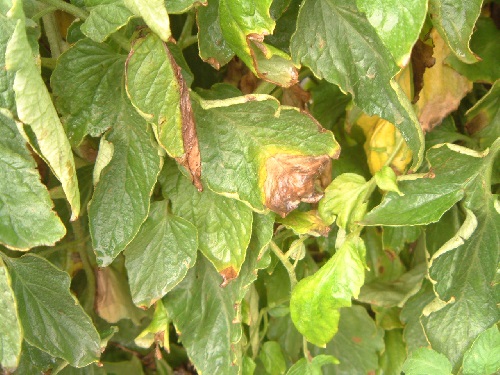Downy Mildew Taking Bite Out Of South Florida Lettuce Crop
Disease Specs
Lettuce downy mildew, caused by the oomycete pathogen Bremia lactucae, has been active in South Florida this winter aided by cool damp conditions. Primarily a foliar disease, it has a direct effect on yield and quality as it affects the marketable portion of the crop.

Photo by Gerald Holmes
Identification
Downy mildew causes light green to yellow angular spots on the upper surfaces of leaves. White mycelial growth of the pathogen develops on the under sides of these spots. Over time, these lesions turn brown and dry up. Older leaves are attacked first. Severely infected leaves may die. In some instances, the pathogen can become systemic, causing discoloration of stem tissue.
Transplants might be infected in the greenhouse. If downy mildew infects the cotyledons of young seedlings, the plants might die. Although yield losses in the field may be substantial, downy mildew’s impact often is accentuated by significant postharvest losses during transit or storage.
Survival And Spread
Damp, cool conditions and moisture on leaves are required for the pathogen to infect lettuce and cause symptoms to develop. The short-lived spores are dispersed by winds during moist periods. Cultivated lettuce is the main host. B. lactucae apparently does not survive in the soil.
B. lactucae is a complex organism, consisting of multiple races (at least 13 races) in Florida. In addition, the pathogen is highly variable and dynamic, resistant cultivars do not remain resistant indefinitely and are overcome by virulent isolates. New races continue to occur as the pathogen changes.
Management Methods
Cultivar resistance when available is the most economical form of downy mildew control. Since many Florida cultivars are susceptible, downy mildew is extremely difficult to control once an outbreak has occurred. For this reason, prevention and early detection are important.
Establishment of a lettuce-free period, crop rotation, the destruction of weed hosts, and rapid incorporation of crop residues also are recommended control measures.
In the absence of resistant cultivars, the alternative is to apply fungicides before the development of the disease. Greenhouse-grown transplants should especially be protected so that downy mildew is not distributed and brought to the field on transplants.
Use of drip or furrow irrigation can help reduce leaf wetness and humidity and reduce the severity of disease but will not prevent disease when weather conditions are conducive to epidemics.
Available fungicides are mostly protectants and must be applied before infection occurs for best results.
Growers should employ a consistent preventative program using mancozeb and a phosphite. Once infections are present in a field, consider some of the more specific oomycete fungicides with translaminar or systemic activity such as Zampro (ametoctradin and dimethomorph, BASF), Ranman (cyazofamid, FMC Corp.), and Aliette (aluminum tris, Bayer CropScience).
A new fungicide, Orondis (mefenoxam, Syngenta) has been demonstrated as being very effective on lettuce downy mildew in Florida, and could be a good candidate for the rotation.










